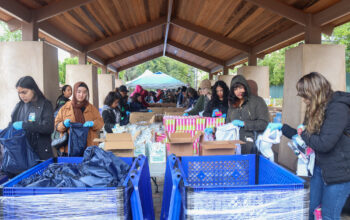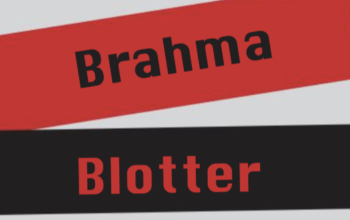Natalie Yemenidjian
In a crowd of almost 8,500 immigrant rights activists at MacArthur Park Thursday, the police stood out as the proverbial elephant in the room.
May 1 last year, the park was the scene of what Los Angeles Police Department Chief William Bratton referred to in an interview with National Public Radio as an embarrassing scene.
The same police department that shot rubber bullets at protestors and journalists alike made peaceful gestures towards the “May Day” participants this year, by guiding the march and repeating phrases on bullhorns such as “welcome to your May Day rally.”
Janitors and the business owners they work for, Priests and parishioners, teachers and students, bus drivers and riders symbiotically created a salad bowl of activism.
Simultaneously, throngs of protesters repeatedly yelled “Si se puede,” on their way to 1st and Broadway Streets-the intersection where three bodies of activists intertwined without a hitch.
Before their convergence, Pierce College student Bryan Lopez prepared for the march.
“It’s a lot more organized this time because the UCLA Labor Center and the Dolores Huerta Labor Institute are actually providing sort of security training so that way people that are going to be in the march can get involved before the LAPD can get involved,” said Lopez. “And that way our own people won’t hurt our own as bad as LAPD will.”
Many community college students like Lopez rallied for the California Dream Act, also known as Senate Bill 1301, which would allow illegal immigrants to compete for scholarships and financial aid.
Mothers held signs that said, “pass the Dream Act” with what Shirley Chavaria, direction of education programs with the Central American Research program (CARECEN), said was not a priority of theirs.
“To be honest with you I think that we’ve kind of fallen off of the Dream Act conversation. I think that our position as been more about to support comprehensive reform,” said Chavaria.
A specific path of legalization for the illegal immigrants in the country right now is a more pressing issue for them. At the same time, protestors from CARECEN held signs in favor of the act.
“They’re thinking about their children who have a real issue they have to face,” said Chavaria. “I’m a legal immigrant here so I can think about things on a bigger picture, whereas others don’t have that luxury.”
As a refuge from Nicaragua, Chavria was able to graduate from Stanford University with a degree in sociology.
“Because of the US’s relationship with Nicaragua I was granted political asylum whereas Salvadorians were not granted that same opportunity and had to really fight to have refuge status in this country,” said Chavria. “I think the political relationship with Mexico really keeps undocumented Mexicans out of that process as well.”
Pierce College student Tania Tchapanian disagrees with legalizing the immigrants that have made it across the border.
“It’s not fair for the people that went through the whole process,” said Tchapanian, who is half-Armenian and half-Mexican. “People before hand had to get the papers to become a citizen and be a part of society. They seclude themselves from society and they don’t have to work their way up in the same way.”
Tchapanian’s mother came to America in the ’70s.
“I don’t know how the process works now. I can imagine it’s harder,” said Tchapanian.

LUNCH BREAK ()

THE AMERICAN DREAM ()



